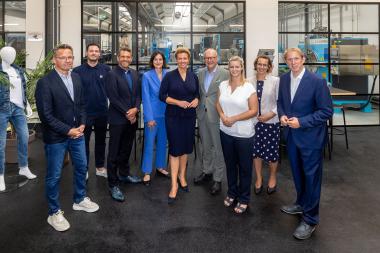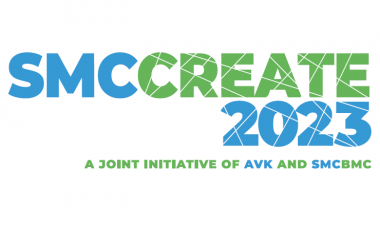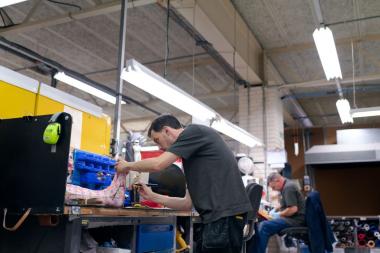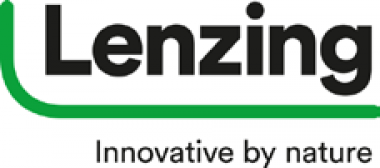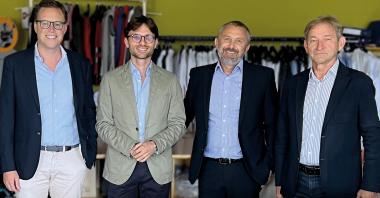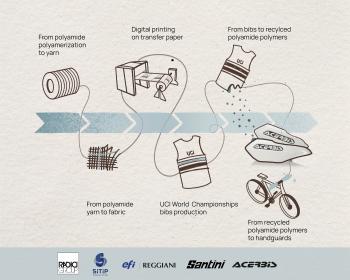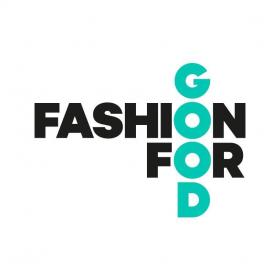Ministerin informiert sich über Textilfabrik 7.0 und Cyber Security Campus in Mönchengladbach
Ina Brandes, Kultur- und Wissenschaftsministerin Nordrhein-Westfalens, hat sich am Mittwochnachmittag an der Hochschule Niederrhein (HSNR) über das Strukturwandelprojekt Textilfabrik 7.0 und die Fortschritte beim Cyber Campus NRW informiert. Eingeladen hatten Jochen Klenner und Vanessa Odermatt (beide CDU), Landtagsabgeordnete für Mönchengladbach.
Im ersten Teil des Besuchs stand das Thema Textil und insbesondere der aktuelle Planungsstand für die Textilfabrik 7.0 (T7) auf dem Programm. Die T7 ist ein Projekt im Rahmen des Strukturwandels im Rheinischen Braunkohlerevier und wird gemeinsam vom Forschungsinstitut für Textil und Bekleidung der Hochschule Niederrhein, des Instituts für Textiltechnik an der RWTH Aachen, des Verbandes der Nordwestdeutschen Textil- und Bekleidungsindustrie sowie des Verbandes der Rheinischen Textil- und Bekleidungsindustrie, mit der Textilakademie NRW sowie der WFMG für die Stadt Mönchengladbach vorangetrieben.
In der T7 soll sowohl die Digitalisierung mit den Themen Künstliche Intelligenz, Robotisierung oder Cyber-Security als auch die Ökologisierung der Produktion hin zur Emissionsfreiheit adressiert werden. Das Großprojekt soll damit eine wettbewerbsfähige Industrieproduktion der Zukunft am Beispiel der Textil- und Modewirtschaft entwickeln. Übergeordnete Ziele sind die Schaffung neuer Arbeitsplätze über alle Qualifizierungsebenen auf einer nachhaltigen Basis und die Weiterentwicklung von Technik und Konzepten – Nachhaltige Produktionsmethoden und Ressourceneinsatz, Kreislaufwirtschaft oder konsequente Digitalisierung in Richtung KI – für die Textilbranche.
Einen ersten Eindruck, wie nachhaltig die Textilproduktion der Zukunft aussehen kann, erhielt die Ministerin beim Besuch des innovativen Start-ups 140Fahrenheit. Das Unternehmen revolutioniert die konventionelle Art der Denim-Veredelung dank modernster Laser-, Wasch- und Wasserrecycling-Technologie am Standort Mönchengladbach. Mit C&A, einer der weltweit größten Denim Brands, ist es 140Fahrenheit gelungen, von Beginn an eine langfristige Kooperation einzugehen und dieses Projekt gemeinsam erfolgreich und nachhaltig weiterzuentwickeln. Das Unternehmen des Gründers Felix Holtgrave übernimmt die "Veredelung" des Produkts.
Die Jeans werden in großen Maschinen gewaschen, getrocknet und dann unter den Strahl eines Lasers gelegt, der ohne Wasser oder Chemikalien die Waschung vornimmt, so dass sie einen mehr oder weniger gealterten oder Vintage-Effekt erhalten. Der Strom, der in der Anlage verwendet wird, stammt zu 70 % aus Windenergie und zu 30 % aus Photovoltaik. Das Wasser, das zum Teil im Kreislauf wiederverwendet wird, wird durch die von den riesigen Wäschetrocknern erzeugte Wärme erhitzt. Pro Jeans werden derzeit etwa zehn Liter Wasser benötigt (mit dem Ziel, dies in Zukunft auf fünf Liter zu reduzieren), verglichen mit fast 69 bis 90 Litern in der herkömmlichen Produktion.
Nur wenige Meter weiter residiert der Cyber Campus NRW (CCNRW), ein vom Ministerium für Kultur und Wissenschaft des Landes Nordrhein-Westfalen finanziertes Gemeinschaftsprojekt der Hochschule Niederrhein und der Hochschule Bonn Rhein-Sieg. Mehr als sechs Millionen Euro hatte das Ministerium für Kultur und Wissenschaft für die Pilotphase bis Ende 2023 zur Verfügung gestellt.
Ministerin Ina Brandes: „Künstliche Intelligenz und Cybersicherheit sind die großen Zukunftsthemen, die das Leben aller Menschen betreffen. Mit der Textilfabrik 7.0 und dem Cyber Security Campus bildet die Hochschule Niederrhein Studentinnen und Studenten in diesen so wichtigen Feldern nah an den Bedürfnissen des Arbeitsmarktes aus und macht junge Menschen zu Fachkräften, die wir so dringend brauchen. Damit leistet die Hochschule einen wichtigen Beitrag für den Wirtschaftsstandort und den Wohlstand in unserem Land.“
Cyber Campus NRW Textilfabrik 7.0 Hochschule Niederrhein, Fashion, Mönchengladbach
Hochschule Niederrhein


